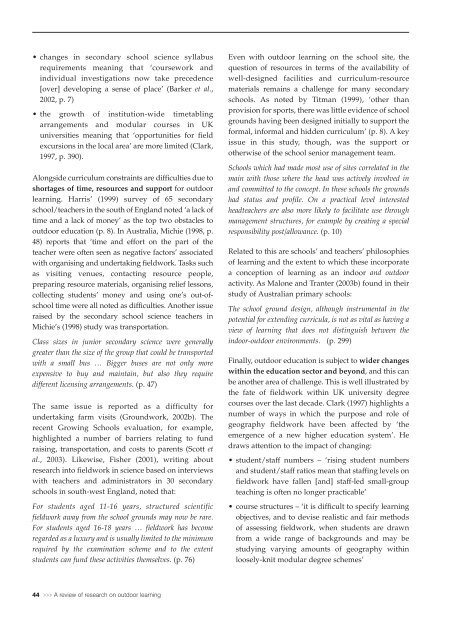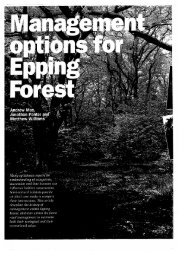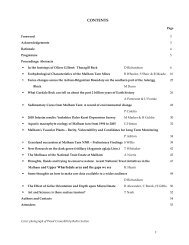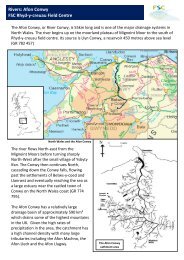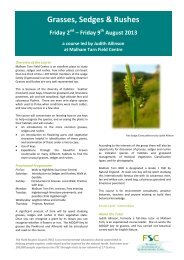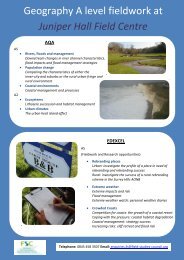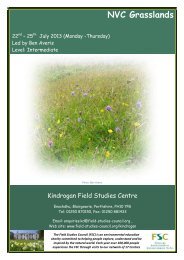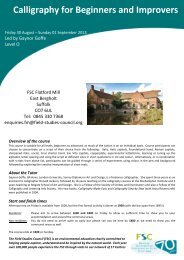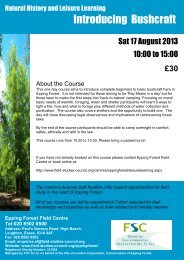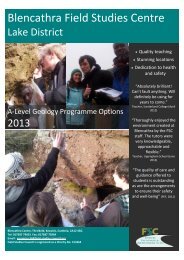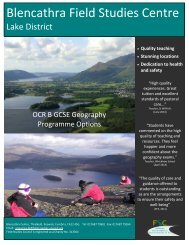A review of research on outdoor learning - Field Studies Council
A review of research on outdoor learning - Field Studies Council
A review of research on outdoor learning - Field Studies Council
- No tags were found...
You also want an ePaper? Increase the reach of your titles
YUMPU automatically turns print PDFs into web optimized ePapers that Google loves.
• changes in sec<strong>on</strong>dary school science syllabusrequirements meaning that ‘coursework andindividual investigati<strong>on</strong>s now take precedence[over] developing a sense <str<strong>on</strong>g>of</str<strong>on</strong>g> place’ (Barker et al.,2002, p. 7)• the growth <str<strong>on</strong>g>of</str<strong>on</strong>g> instituti<strong>on</strong>-wide timetablingarrangements and modular courses in UKuniversities meaning that ‘opportunities for fieldexcursi<strong>on</strong>s in the local area’ are more limited (Clark,1997, p. 390).Al<strong>on</strong>gside curriculum c<strong>on</strong>straints are difficulties due toshortages <str<strong>on</strong>g>of</str<strong>on</strong>g> time, resources and support for <strong>outdoor</strong><strong>learning</strong>. Harris’ (1999) survey <str<strong>on</strong>g>of</str<strong>on</strong>g> 65 sec<strong>on</strong>daryschool/teachers in the south <str<strong>on</strong>g>of</str<strong>on</strong>g> England noted ‘a lack <str<strong>on</strong>g>of</str<strong>on</strong>g>time and a lack <str<strong>on</strong>g>of</str<strong>on</strong>g> m<strong>on</strong>ey’ as the top two obstacles to<strong>outdoor</strong> educati<strong>on</strong> (p. 8). In Australia, Michie (1998, p.48) reports that ‘time and effort <strong>on</strong> the part <str<strong>on</strong>g>of</str<strong>on</strong>g> theteacher were <str<strong>on</strong>g>of</str<strong>on</strong>g>ten seen as negative factors’ associatedwith organising and undertaking fieldwork. Tasks suchas visiting venues, c<strong>on</strong>tacting resource people,preparing resource materials, organising relief less<strong>on</strong>s,collecting students’ m<strong>on</strong>ey and using <strong>on</strong>e’s out-<str<strong>on</strong>g>of</str<strong>on</strong>g>schooltime were all noted as difficulties. Another issueraised by the sec<strong>on</strong>dary school science teachers inMichie’s (1998) study was transportati<strong>on</strong>.Class sizes in junior sec<strong>on</strong>dary science were generallygreater than the size <str<strong>on</strong>g>of</str<strong>on</strong>g> the group that could be transportedwith a small bus … Bigger buses are not <strong>on</strong>ly moreexpensive to buy and maintain, but also they requiredifferent licensing arrangements. (p. 47)The same issue is reported as a difficulty forundertaking farm visits (Groundwork, 2002b). Therecent Growing Schools evaluati<strong>on</strong>, for example,highlighted a number <str<strong>on</strong>g>of</str<strong>on</strong>g> barriers relating to fundraising, transportati<strong>on</strong>, and costs to parents (Scott etal., 2003). Likewise, Fisher (2001), writing about<str<strong>on</strong>g>research</str<strong>on</strong>g> into fieldwork in science based <strong>on</strong> interviewswith teachers and administrators in 30 sec<strong>on</strong>daryschools in south-west England, noted that:For students aged 11-16 years, structured scientificfieldwork away from the school grounds may now be rare.For students aged 16-18 years … fieldwork has becomeregarded as a luxury and is usually limited to the minimumrequired by the examinati<strong>on</strong> scheme and to the extentstudents can fund these activities themselves. (p. 76)Even with <strong>outdoor</strong> <strong>learning</strong> <strong>on</strong> the school site, thequesti<strong>on</strong> <str<strong>on</strong>g>of</str<strong>on</strong>g> resources in terms <str<strong>on</strong>g>of</str<strong>on</strong>g> the availability <str<strong>on</strong>g>of</str<strong>on</strong>g>well-designed facilities and curriculum-resourcematerials remains a challenge for many sec<strong>on</strong>daryschools. As noted by Titman (1999), ‘other thanprovisi<strong>on</strong> for sports, there was little evidence <str<strong>on</strong>g>of</str<strong>on</strong>g> schoolgrounds having been designed initially to support theformal, informal and hidden curriculum’ (p. 8). A keyissue in this study, though, was the support orotherwise <str<strong>on</strong>g>of</str<strong>on</strong>g> the school senior management team.Schools which had made most use <str<strong>on</strong>g>of</str<strong>on</strong>g> sites correlated in themain with those where the head was actively involved inand committed to the c<strong>on</strong>cept. In these schools the groundshad status and pr<str<strong>on</strong>g>of</str<strong>on</strong>g>ile. On a practical level interestedheadteachers are also more likely to facilitate use throughmanagement structures, for example by creating a specialresp<strong>on</strong>sibility post/allowance. (p. 10)Related to this are schools’ and teachers’ philosophies<str<strong>on</strong>g>of</str<strong>on</strong>g> <strong>learning</strong> and the extent to which these incorporatea c<strong>on</strong>cepti<strong>on</strong> <str<strong>on</strong>g>of</str<strong>on</strong>g> <strong>learning</strong> as an indoor and <strong>outdoor</strong>activity. As Mal<strong>on</strong>e and Tranter (2003b) found in theirstudy <str<strong>on</strong>g>of</str<strong>on</strong>g> Australian primary schools:The school ground design, although instrumental in thepotential for extending curricula, is not as vital as having aview <str<strong>on</strong>g>of</str<strong>on</strong>g> <strong>learning</strong> that does not distinguish between theindoor-<strong>outdoor</strong> envir<strong>on</strong>ments. (p. 299)Finally, <strong>outdoor</strong> educati<strong>on</strong> is subject to wider changeswithin the educati<strong>on</strong> sector and bey<strong>on</strong>d, and this canbe another area <str<strong>on</strong>g>of</str<strong>on</strong>g> challenge. This is well illustrated bythe fate <str<strong>on</strong>g>of</str<strong>on</strong>g> fieldwork within UK university degreecourses over the last decade. Clark (1997) highlights anumber <str<strong>on</strong>g>of</str<strong>on</strong>g> ways in which the purpose and role <str<strong>on</strong>g>of</str<strong>on</strong>g>geography fieldwork have been affected by ‘theemergence <str<strong>on</strong>g>of</str<strong>on</strong>g> a new higher educati<strong>on</strong> system’. Hedraws attenti<strong>on</strong> to the impact <str<strong>on</strong>g>of</str<strong>on</strong>g> changing:• student/staff numbers – ‘rising student numbersand student/staff ratios mean that staffing levels <strong>on</strong>fieldwork have fallen [and] staff-led small-groupteaching is <str<strong>on</strong>g>of</str<strong>on</strong>g>ten no l<strong>on</strong>ger practicable’• course structures – ‘it is difficult to specify <strong>learning</strong>objectives, and to devise realistic and fair methods<str<strong>on</strong>g>of</str<strong>on</strong>g> assessing fieldwork, when students are drawnfrom a wide range <str<strong>on</strong>g>of</str<strong>on</strong>g> backgrounds and may bestudying varying amounts <str<strong>on</strong>g>of</str<strong>on</strong>g> geography withinloosely-knit modular degree schemes’44 >>> A <str<strong>on</strong>g>review</str<strong>on</strong>g> <str<strong>on</strong>g>of</str<strong>on</strong>g> <str<strong>on</strong>g>research</str<strong>on</strong>g> <strong>on</strong> <strong>outdoor</strong> <strong>learning</strong>


